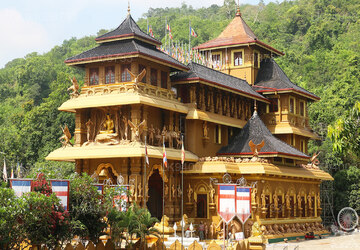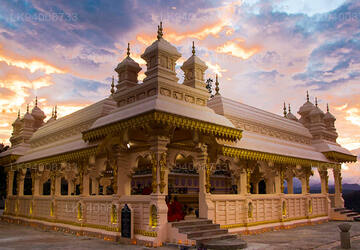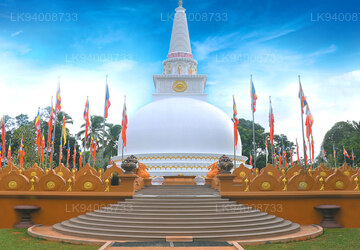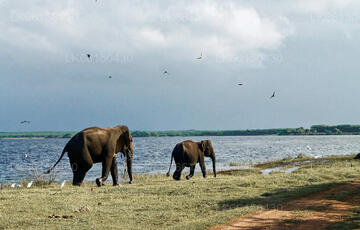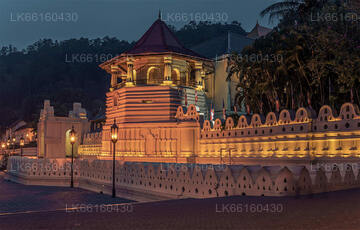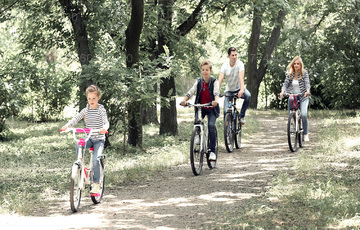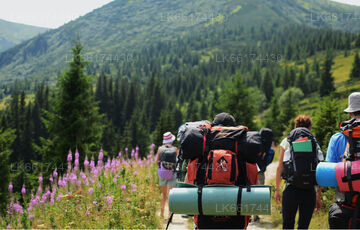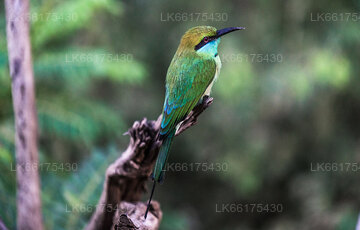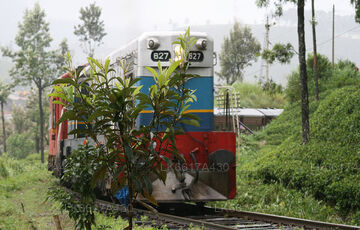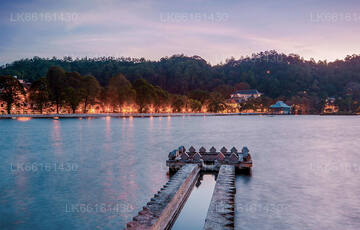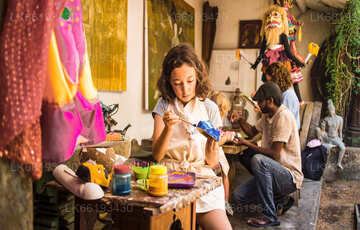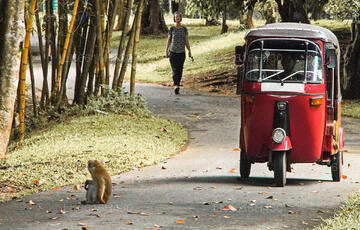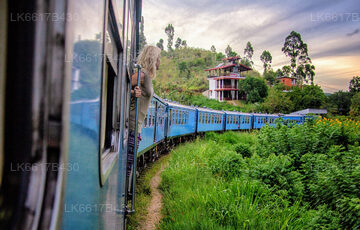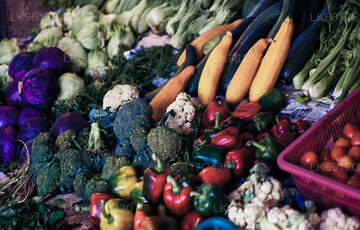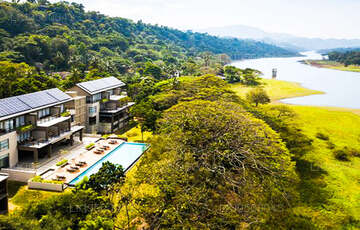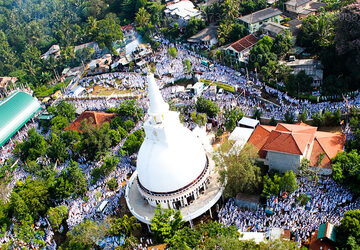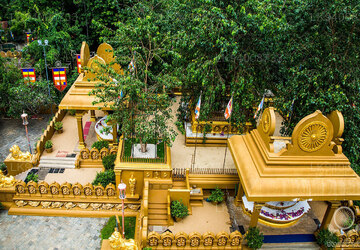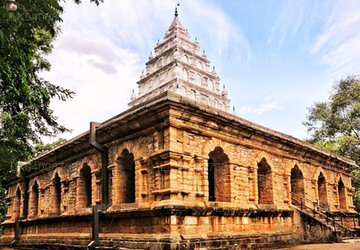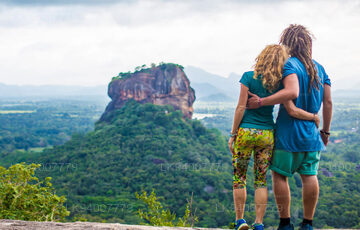

Kandy City
Kandy, a picturesque city in central Sri Lanka, is renowned for its rich cultural heritage, vibrant festivals, and scenic beauty. Nestled amidst lush hills, it is home to the Temple of the Tooth Relic, a UNESCO World Heritage Site, and offers a captivating blend of history and natural splendor.
Kundasale
Über Kundasale
Kundasale ist eine ehemalige Stadt, heute ein Vorort von Kandy im Distrikt Kandy in der Zentralprovinz Sri Lankas. Die Stadt liegt 7 km südöstlich des Zentrums von Kandy. Die Bevölkerung beträgt etwa 150.000.
Kundasale-Geschichte
König Vira Parakrama Narendra Sinha, der letzte singhalesische König von Kandy, beschloss 1710, seinen Palast von Kandy nach Kundasale zu verlegen. Er beauftragte den örtlichen Gouverneur Ramukwelle Dissawe mit dem Bau des Palastkomplexes. Rambukwelle Dissawe engagierte die Dienste eines Baumeisters, Devendra, der den Palast vollständig aus Holz auf einem Hügel in einem Garten, Narikele, errichtete. Der Palast soll eher ein Sommerpalast als ein königlicher Palast gewesen sein. Er war der erste und letzte König, der Kundasale zur Hauptstadt des Königreichs Kandyan machte. Der König starb im Mai 1739 und 1804 griffen britische Truppen unter dem Kommando von Kapitän Arthur Johnson den Palast an, plünderten seine Wertgegenstände und brannten ihn nieder. Die Überreste des Gebäudes wurden für den Bau des nahegelegenen Sri Narendrasinhe Rajamaha Viharaya verwendet. Die beiden steinernen Elefantenschnitzereien am Haupteingang, Mahawahalkada, von Sri Dalada Maligawa (Tempel der heiligen Zahnreliquie) stammen angeblich aus den Ruinen des Kundasale-Palastes. Sie wurden jedoch 1989 beim Angriff der Janatha Vimukthi Peramuna auf den Tempel zerstört.
Über den Bezirk Kandy
Der Bezirk Kandy liegt in der Zentralprovinz Sri Lankas. Als eine der sieben Weltkulturerbestätten in Sri Lanka war Kandy im 16. Jahrhundert einst die Heimat der einstigen Kandyan-Könige und eine Quelle der gesamten Musik, Kunst, Handwerkskunst und Kultur des Landes. Kandy liegt etwa 129 km von Colombo entfernt inmitten einer hügeligen Landschaft und alle Blicke werden auf das Stadtzentrum gelenkt, wo der Kandy-See ein bezauberndes Wahrzeichen darstellt. Kandy hat für Sri Lanka nach wie vor eine große religiöse Bedeutung, denn in dieser bezaubernden Stadt befindet sich der Dalada Maligawa oder „Zahntempel“, in dem die heilige Zahnreliquie von Lord Buddha gut bewacht liegt. Der Königliche Botanische Garten Peradeniya liegt etwa 5 km westlich des Stadtzentrums von Peradeniya und wird jährlich von 1,2 Millionen Menschen besucht. Es ist der größte botanische Garten der Insel. Der Udawatta Kele (Udawatta-Wald) ist ein geschütztes Heiligtum im Herzen der Stadt, nördlich des Zahntempels. Kandy ist eine Stadt mit singhalesischer Mehrheit; Es gibt beträchtliche Gemeinschaften, die anderen ethnischen Gruppen angehören, beispielsweise Mauren und Tamilen. Kandy ist nach Colombo das zweitgrößte Wirtschaftszentrum Sri Lankas. Viele große Kooperationen haben große Niederlassungen in Kandy und viele Branchen wie Textilien, Möbel, Informationstechnologie und Schmuck sind hier zu finden. In der Stadt gibt es viele landwirtschaftliche Forschungszentren. und eine Quelle für die gesamte Musik, Kunst, Kunsthandwerk und Kultur des Landes. Kandy liegt etwa 129 km von Colombo entfernt inmitten einer hügeligen Landschaft und alle Blicke werden auf das Stadtzentrum gelenkt, wo der Kandy-See ein bezauberndes Wahrzeichen darstellt. Kandy hat für Sri Lanka weiterhin eine große religiöse Bedeutung, denn in dieser bezaubernden Stadt befindet sich der Dalada Maligawa oder Zahntempel, in dem die heilige Zahnreliquie von Lord Buddha gut bewacht liegt.
Über die Zentralprovinz
Die Zentralprovinz Sri Lankas besteht hauptsächlich aus bergigem Gelände. Die Provinz hat eine Fläche von 5.674 km² und eine Bevölkerung von 2.421.148. Zu den größeren Städten zählen Kandy, Gampola (24.730), Nuwara Eliya und Bandarawela. Die Bevölkerung ist eine Mischung aus Singhalesen, Tamilen und Mauren. Sowohl die Berghauptstadt Kandy als auch die Stadt Nuwara Eliya liegen in der Zentralprovinz sowie in Sri Pada. Die Provinz produziert einen Großteil des berühmten Ceylon-Tees, den die Briten in den 1860er Jahren anpflanzten, nachdem eine verheerende Krankheit alle Kaffeeplantagen in der Provinz zerstört hatte. Die Zentralprovinz zieht viele Touristen mit Bergstädten wie Kandy, Gampola, Hatton und Nuwara Eliya an. Tempelzahn oder Dalada Maligawa ist der wichtigste heilige Ort in der Zentralprovinz. Das Klima ist kühl und in vielen Gegenden um 1500 Meter sind die Nächte oft kühl. Die Westhänge sind sehr nass, stellenweise fallen fast 7000 mm Regen pro Jahr. Die Osthänge sind Teile der mitteltrockenen Zone, da es nur vom Nordostmonsun regnet. Die Temperaturen reichen von 24°C in Kandy bis zu nur 16°C in Nuwara Eliya, das 1.889 m über dem Meeresspiegel liegt. Die höchsten Berge Sri Lankas liegen in der Zentralprovinz. Das Gelände ist größtenteils gebirgig und weist tiefe Täler auf. Die beiden Hauptgebirgsregionen sind das Zentralmassiv und die Knuckles-Bergkette östlich von Kandy.
About Kandy District
Kandy district is situated in the centrel province of Sri Lanka. One of the seven World Heritage Sites in Sri Lanka, Kandy was once home to the Kandyan Kings of yore in the 16th-century and a fountainhead for all the music, arts, crafts and culture in the country. About 129 km away from Colombo, Kandy is ensconced amongst a hilly terrain and all eyes are drawn to the centre of the city, where the Kandy Lake forms a charming feature. Kandy retains great religious significance for Sri Lanka, because it is in this charming city that the Dalada Maligawa or "Temple of the Tooth" is located, within which the sacred tooth relic of Lord Buddha lies well guarded.
The Royal Botanical Garden, Peradeniya is situated about 5 km to the west of the city centre at Peradeniya and is visited by 1.2 million people per year. It is the largest botanical garden on the island. The Udawatta Kele (Udawatta Forest) is a protected sanctuary situated in the heart of the city, just north of Temple of the Tooth.
Kandy is a Sinhala majority city; there are sizeable communities belonging to other ethnic groups, such as Moors and Tamils. Kandy is second only to Colombo the center of the Sri Lankan Economy. Many major co operations have large branch officers in Kandy and many industries include textiles, furniture, Information Technology and jewellery are found here. Many agriculture research centers are located in the city.
And a fountainhead for all the music, arts, crafts and culture in the country. About 129 km away from Colombo, Kandy is ensconced amongst a hilly terrain and all eyes are drawn to the centre of the city, where the Kandy Lake forms a charming feature. Kandy retains great religious significance for Sri Lanka , because it is in this charming city that the Dalada Maligawa or Temple of the Toothis located, within which the sacred tooth relic of Lord Buddha lies well guarded.
About Central Provincce
The Central Province of Sri Lanka consists primarily of mountainous terrain. The province has an area of 5,674 km², and a population of 2,421,148. Some major towns include Kandy, Gampola (24,730), Nuwara Eliya and Bandarawela. The population is a mixture of Sinhalese, Tamil and the Moors.
Both the hill capital Kandy and the city of Nuwara Eliya are located within the Central Province as well as Sri Pada. The province produces much of the famous Ceylon tea, planted by the British in the 1860s after a devastating disease killed all the coffee plantations in the province. Central Province attracts many tourists, with hill station towns such as Kandy, Gampola, Hatton and Nuwara Eliya. Temple tooth or Dalada maligawa is the main sacred place in Centrel province.
The climate is cool, and many areas about 1500 meters often have chilly nights. The western slopes are very wet, some places having almost 7000 mm of rain per year. The eastern slopes are parts of the mid-dry zone as it is receiving rain only from North-Eastern monsoon. The Temperatures range from 24°C at Kandy to just 16°C in Nuwara Eliya, which is located 1,889 m above sea level. The highest mountains in Sri Lanka are located in the Central Province. The terrain is mostly mountainous, with deep valleys cutting into it. The two main mountain regions are the central massif and the Knuckles range to the east of Kandy.

